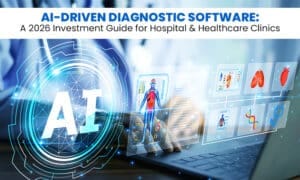
Healthcare providers and diagnostic businesses face growing pressure to detect liver disorders early. One of the most common liver-related conditions is jaundice, which often signals deeper clinical concerns. Symptoms of jaundice frequently appear in outpatient visits, routine diagnostics, and emergency room encounters. Recognising these symptoms quickly and consistently helps medical organisations improve outcomes, reduce unnecessary hospitalisation, and enhance diagnostic accuracy.
This guide is designed for hospital administrators, clinical lab executives, and digital health solution providers. It outlines the signs of jaundice in adults, the early signs of jaundice, and explores how providers can integrate better detection workflows across their operations.
What is Jaundice? (A Quick Recap)
Jaundice results from an accumulation of high bilirubin levels in the bloodstream. Bilirubin, a yellow pigment, builds up when the liver cannot process or eliminate it efficiently. This leads to the most recognised sign—yellowing of skin and eyes.
Jaundice can arise from various conditions, including hepatitis, liver cirrhosis, gallstones, haemolytic anaemia, and even certain medications. Healthcare teams must look beyond surface symptoms to identify the root cause. Understanding what are the early symptoms related to jaundice? allows providers to act before the condition becomes critical.
Key Jaundice Symptoms to Watch For
An accurate understanding of the symptoms related to jaundice is essential in both primary care and hospital settings. Below are the most common indicators, grouped by patient presentation.
1. Yellowing of Skin and Eyes
The most visible sign of jaundice is the skin becoming yellow and sclera (white of the eyes). This occurs when high bilirubin levels seep into tissues. In clinical practice, this often prompts immediate lab testing.
2. Dark Urine and Pale Stools
These colour changes are tell-tale signs that bilirubin isn’t being excreted correctly. Healthcare teams should note these symptoms as early triggers to perform liver function tests (LFTs).
3. Fatigue and Abdominal Pain
Patients with jaundice often complain of exhaustion or discomfort near the upper right abdomen. This can indicate swelling in the liver or bile duct obstruction—warranting urgent investigation.
4. Itching and Nausea
Chronic liver conditions may cause systemic reactions, such as itching and a constant feeling of nausea. These early signs of jaundice can easily be overlooked unless a standardised evaluation protocol is in place.
5. Jaundice Symptoms in Newborns and Infants
Neonatal jaundice is very common in the first week of life. Jaundice symptoms in newborns and infants include lethargy, feeding difficulty, and a yellow tinge on the skin, particularly on the face. This must be closely monitored using bilirubin metres and follow-up diagnostics.

Why Symptom Recognition Matters for B2B Healthcare
In today’s healthcare landscape, the question “How to know if you have jaundice?” is more than just a patient inquiry—it’s a critical signal for medical labs, hospitals, and digital health solution providers to build automated and standardised diagnostic pathways. Timely recognition of symptoms of jaundice enables faster intervention, improves patient outcomes, and enhances clinical decision-making.
1. Accelerated Diagnosis
For diagnostic labs and clinical service providers, early symptom detection means improved turnaround times. Systems that can analyse lab data and patient-reported cues such as yellowing of skin or fatigue—combined with high bilirubin levels—can instantly flag potential jaundice cases. These automated triggers reduce diagnostic delays and ensure patients receive proper liver function testing and care without administrative lags.
2. Telehealth Triage Efficiency
With virtual healthcare gaining traction, especially in rural and underserved regions, recognising early signs of jaundice through digital platforms is critical. Telehealth platforms must be equipped to process voice or chat-based cues like “What are the early symptoms of jaundice?”, guiding the patient toward appropriate care pathways. These systems support both initial triage and real-time medical routing.
3. Integration with Hospital Information Systems
HIMS software developers should integrate dashboards that automatically track indicators like high bilirubin levels, signs of jaundice in adults, and previous encounters showing yellow skin. These tools help clinicians monitor symptom progression and deliver preventive care across outpatient and inpatient departments.
For B2B healthcare to evolve, recognising and responding to symptoms leading to jaundice must be a core feature of modern diagnostic and care delivery platforms.
Enhancing Diagnostic Workflows: What to Prioritise
For hospitals, diagnostic labs, and health tech providers, improving jaundice detection starts with optimising the right tools and workflows. As patient volumes rise, the ability to respond quickly to queries like “What are the early symptoms of jaundice?” or “How to know if you have jaundice?” becomes critical. B2B healthcare vendors must focus on creating diagnostic systems that integrate real-time symptom data with clinical testing to catch liver disorders early and accurately.
• Bilirubin Tracking Tools
Since high bilirubin levels are the root cause of jaundice, any modern lab information system must offer tools to track bilirubin trends across visits. These tools should integrate directly with liver function test (LFT) panels and be capable of auto-flagging abnormal readings. A centralised dashboard helps doctors instantly correlate lab values with visible jaundice symptoms such as yellowing of skin, enabling prompt diagnosis and treatment.
• Symptom Screening Questionnaires
Standardised symptom collection is essential for improving diagnostic accuracy. Patient-reported issues like fatigue, loss of appetite, pale stools, and yellowing skin can signal early signs of jaundice. Digital onboarding forms in Hospital Information Management Systems (HIMS) should collect these inputs in a structured format. This not only helps detect the signs of jaundice in adults early but also enables care teams to take proactive steps.
• Newborn Screening Protocols
Jaundice symptoms in newborns and infants are often subtle and require diligent monitoring. Diagnostic platforms must include features like bilirubin level trending, phototherapy alerts, and neonatal care guidelines. These protocols ensure early intervention, reducing risks of complications like kernicterus and long-term developmental delays.
Together, these enhancements create a data-driven, symptom-aware approach to jaundice diagnosis in B2B healthcare settings.
Digital Healthcare Solutions and Jaundice Monitoring
The rise of digital healthcare solutions provides an opportunity to reduce clinical oversight and improve disease recognition. HIMS vendors, wearable device companies, and AI-powered health platforms can assist by embedding symptom recognition modules.
Examples:
- AI flags signs of jaundice in adults based on repeated complaints and test results.
- Apps prompt patients to report signs like yellowing of skin or fatigue through visual symptom mapping.
- Teleconsultation tools include structured questions such as “What are the early symptoms leading to jaundice?” before consultations.
Clinical Lab and HIMS Integration Strategy
To streamline the detection and management of jaundice across facilities, consider this integrated model:
Step 1: Pre-Visit Screening
Trigger auto-questionnaires asking, “How to know if you have jaundice?” and related symptoms based on patient records or visit history.
Step 2: Lab Report Synchronisation
Auto-highlight high bilirubin levels in LFTs. Flag them with decision support alerts and link to ICD-10 codes for jaundice-related diagnoses.
Step 3: Doctor Dashboard Customisation
Show physicians a consolidated symptom chart highlighting early signs of jaundice, prior episodes, and lab correlations.
Step 4: Post-Consultation Workflow
If treatment is initiated, provide follow-up reminders and home care education, especially in cases involving jaundice symptoms in newborns and infants.
Outcome & Impact Of Digital Healthcare Solutions For Jaundice

Future Outlook: Symptom-Based AI and Predictive Tools
Between 2025 and 2030, expect more hospitals to shift toward AI-enabled early warning systems. These systems will not only track symptoms related to jaundice but will use predictive analytics to recommend action plans based on:
- Age
- Comorbidities
- High bilirubin levels
- Genetic predispositions
Health tech companies must ensure their solutions capture queries like “What are the early symptoms of jaundice?” and build actionable workflows around them. This will not only support clinicians but also empower patients with proactive care.
Conclusion
The ability to recognise and respond to the symptoms leading to jaundice can transform how providers deliver care and how diagnostics drive early detection. From identifying the yellowing of skin to tracking high bilirubin levels, hospitals, labs, and digital healthcare providers must work together to streamline workflows.
Whether it’s answering “What are the early symptoms of jaundice?” or managing jaundice symptoms in newborns and infants, integrated platforms play a key role. To succeed in today’s patient-cantered landscape, every B2B healthcare stakeholder must embrace data-driven, symptom-aware systems.
Want to know more about early detection strategies? Let’s explore smarter healthcare—together. Check out other blogs available in our website.





